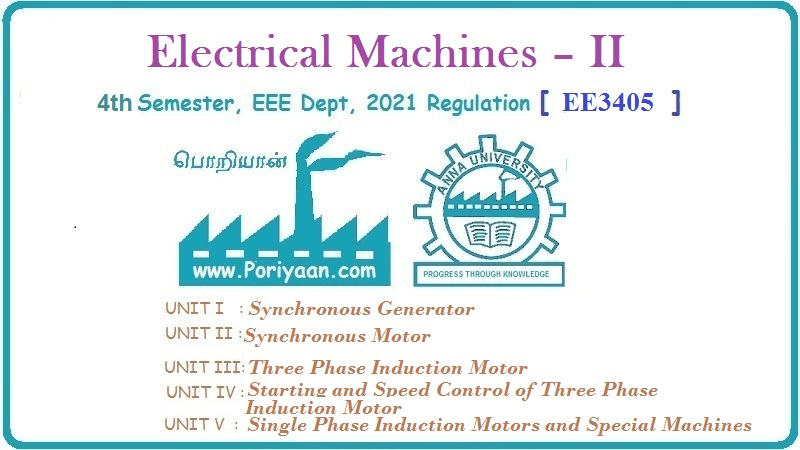Electrical Machines II: UNIT IV: Starting and Speed Control of Three Phase Induction Motor
Two Marks Questions with Answers
Starting and Speed Control of Three Phase Induction Motor | Electrical Machines
Engineering Electrical Machines - II : UNIT IV : Starting, Speed Control and Braking of Induction Motors : Anna University Two Marks Questions & Answers
Two Marks Questions with Answers
Q.
1 A 3-phase squirrel cage induction motor should not be started directly from
the main supply. State reasons, or Why starter is necessary in induction motor
?
Ans. :
The
rotor current in the running condition is given by,

But
at start, the speed of the motor is zero and slip is at its maximum i.e. unity.
So magnitude of rotor induced e.m.f. is very large at start. As rotor
conductors are short circuited, the large induced e.m.f. circulates very high
current through rotor at start. The induction motor acts as a generalised
transformer hence it draws very high current from the supply. Due to such heavy
inrush of current at start there is possibility of damage of the motor winding.
Such sudden inrush of current causes large line voltgae drop which may affect
the working of other appliances connected to the same supply lines. Hence the
starter is necessary for induction motors.
Q.
2 Give the functions performed by induction motor starter. AU : Dec.-05, 14
Ans. :
Apart
from limiting the high starting current, starter in an induction motor also
serves the functions like single phase prevention, prevention of low voltage
operation, thermal shutdown, prevention from overloading etc.
Q.
3 State two advantages of speed control of IM by injecting an e.m.f. in the
rotor circuit.
Ans. :
1.
Smooth and wide range of speed control possible.
2.
Design of rotary converter is independent of the speed control required.
3.
If rotary converter is overexcited, power factor improvement is possible.
4.
The design of the rotary converter is independent of the speed control
required.
Q.
4 Name the type of starters used in 3 phase induction motors.
AU : Dec.-07, 13, 16, May-11
Ans. :
1.
Stator resistance starter
2.
Autotransformer starter
3.
Star-delta starter
4.
Rotor resistance starter
5.
Direct on line starter
Q.
5 Write down the methods to control the speed of 3 phase induction motor from
its rotor side. AU : May-07,17, Dec.-lO
Ans. :
From
rotor side, it includes following methods :
a.
Adding external resistance in the rotor circuit.
b.
Cascade control.
c.
Injecting slip frequency voltage into the rotor circuit.
Q.
6 What is the disadvantage of rotor rheostat speed control method ? AU : May-10
Ans. :
i)
Large power losses due to large I2R losses,
ii)
Efficiency is very low.
iii)
Cannot be used for squirrel cage motor.
iv)
Large speed changes not possible.
Q.7 Draw the star delta starter diagram of three phase cage induction motor.
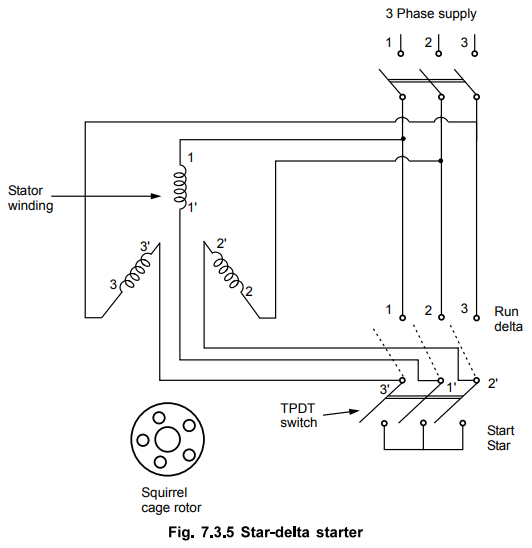
Q.
8 Draw the autotransformer starter diagram of three phase cage induction motor
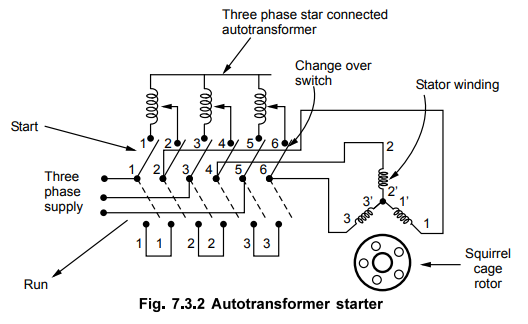
Q.
9 Draw the direct on line starter diagram of three phase cage induction motor.
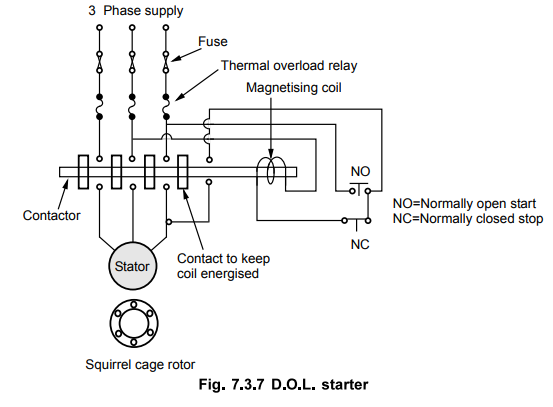
Q.
10 List the various methods speed control of 3 phase induction motor.
Ans. :
From
stator side, it includes following methods :
a.
Supply frequency control to control NS/ called V/f control.
b.
Supply voltage control.
c.
Controlling number of stator poles to control Ns.
d.
Adding rheostats in stator circuit.
From
rotor side, it includes following methods :
a.
Adding external resistance in the rotor circuit.
b.
Cascade control, c. Injecting slip frequency voltage into the rotor circuit.
Q.
11 What will be the effect when stator voltage and frequency of an induction
motor are reduced proportionally ?
Ans. :
When
stator voltage and frequency is reduced proportionally then V/f ratio is
maintained constant. Due to this, the air gap flux remains constant and speed
of the induction motor gets reduced smoothly. The constant V/f ratio avoids the
saturation of the cores resulting into sharp increase in the no load current.
Thus smooth speed control of the induction motor is possible due to constant
V/f ratio.
Q.
12 Draw the diagram of Kramer system of controlling the speed of induction
motor.
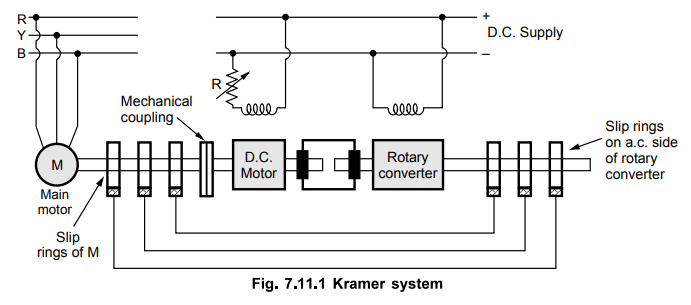
Q.
13 Draw the diagram of Scherbius system of controlling the speed of induction
motor.

Q.
14 By which methods the stator poles can be controlled to control the speed of
an induction motor ?
Ans. :
1.
Consequent poles method
2.
Multiple stator winding method
3.
Pole amplitude modulation method.
Q.
15 What are the limitations of multiple stator winding speed control method ?
Ans. :
1.
Can be applied to only squirrel cage motor.
2.
Smooth speed control is not possible. Only step changes in speed are possible.
3.
Two different stator windings are required to be wound which increases the cost
of the motor.
4.
Complicated from the design point of view.
Q.
16 How many speeds can be obtained by cascade control method ? How ?
Ans. :
Thus
in cascade control, four different speeds are possible as,
a.
With respect to synchronous speed of A independently, Ns = 120 f / PA
b.
With respect to synchronous speed of B independently with main motor is
disconnected and B is directly connected to supply, Ns = 120 f / PB
c.
Running set as cumulatively cascaded with, Ns = 120 f / PA +
PB
d.
Running set as differentially cascaded with, Ns = 120 f / PA -
PB
Q.
17 What are the disadvantages of cascade control method ?
Ans. :
1.
It requires two motors which makes the set expensive.
2.
Smooth speed control is not possible.
3.
Operation is complicated.
4.
The starting torque is not sufficient to start the set.
5.
Set cannot be operated if PA = PB.
Q.
18 Explain in brief the following term with respect to induction motor : a.
Plugging b. Dynamic braking c. D.C. dynamic braking d. Regenerative braking AU
: Dec.-05, May-14
Ans. :
a.
The reversal of direction of rotation of motor is the main principle in
plugging of motor. In case of an induction motor, it can be quickly stopped by
interchanging any two stator leads. Due to this, the direction of rotating
magnetic field gets reversed suddenly. This produces a torque in the reverse
direction and the motor tries to rotate in opposite direction. Effectively the
brakes are applied to the motor.
b.
In this method one supply line out of R, Y or B is disconnected from the
supply.
c.
If the rotor speed is increased greater than the synchronous speed with the
help of external device, it acts as an induction generator. It converts the
input mechanical energy to an electrical energy which is given back to supply.
It delivers active power to the 3 phase line. So rotor produces torque in
opposite direction to achieve the braking. As the electrical energy is given
back to the lines while braking, it is called regenerative braking.
d.
A quick stopping of an induction motor and its high inertia load can be
achieved by connecting stator terminals to a d.c. supply. Any two stator
terminals can be connected to a d.c. supply and third terminal may be kept open
or may be connected directly to other stator terminal. This is called d.c.
dynamic braking.
Q.
19 State the drawback of a star-delta starter.
Ans. :
1.
The factor by which voltage is reduced is fixed i.e. 73.
2.
Only used for normally delta connected motors.
Q.
20 What are the advantages of rotor resistance speed control method ?
Ans. :
1.
Wide range of speed control.
2.
Starting torque gets improved.
3.
Power factor gets improved.
4.
Limits the starting current.
Q.
21 What are the different methods of speed control employed in three phase cage
induction motor ?
Ans. :
The
methods of speed control employed in three phase cage induction motor are,
i)
Supply frequency control to control Ns called V/f control.
ii)
Supply voltage control.
iii)
Controlling number of stator poles to control Ns.
iv)
Adding rheostats in stator circuit.
Q.
22 What is meant by slip power recovery scheme ?
Ans. :
In
the rotor resistance speed control, the slip power in the rotor circuit is
wasted as I2R losses. It is possible to recover the slip power from
the rotor and feed back to the supply using static devices. Such a scheme of
revecovering slip power from rotor is called slip power recovery scheme. The
slip power recovered from rotor is either returned to the supply or used to drive
on auxiliary motor which is mechanically coupled to the main induction motor.
Q.
23 Which is the cheapest method of starting a three phase induction motor ?
Ans. :
The
star-delta starter is the cheapest method of starting induction motor.
Q.
24 While controlling the speed of an induction motor, how is super-synchronous
speed achieved ?
Ans. :
It
is possible by injecting slip frequency e.m.f. in the rotor circuit, in phase
with the rotor induced e.m.f.
Q.
25 Explain plugging in three phase induction motor.
Ans. :
The
reversal of direction of rotation of motor is the main principle in plugging of
motor. In case of an induction motor, it can be quickly stopped by
interchanging any two stator leads. Due to this, the direction of rotating
magnetic field gets reversed suddenly.
This produces a torque in the reverse direction and the motor tries to rotate
in opposite direction. Effectively the brakes are applied to the motor. Thus
during the plugging, the motor acts as a brake.
Q.
26 Define regenerative braking of induction motors.
Ans. :
If
the rotor speed is increased greater than the synchronous speed with the help
of external device, it acts as an induction generator. It converts the input
mechanical energy to an electrical energy which is given back to supply. It
delivers active power to the 3 phase line. The becomes greater than 90°. The
power flow reverses hence rotor induced e.m.f. and rotor current also reverse.
So rotor produces torque in opposite direction to achieve the braking. As the
electrical energy is given back to the lines while braking, it is called
regenerative braking.
Q.
27 When plugging is employed for stopping an induction motor, why is it
necessary to disconnect it from supply when the speed reaches close to zero ? AU
: May-09
Ans. :
If
the induction motor is not disconnected from the supply after reaching zero
speed in plugging, then motor will get accelerated in reverse direction and
will start rotating in reverse direction. This may lead to damage of the load.
Q.
28 State the advantages of electrical braking.
Ans. :
1)
It is easier and reliable
2)
Smooth stop is possible
3)
Brings motor to rest very quickly.
4)
Levers, mechanical brakes, linings etc. are not required. So cheap.
5)
Portion of the power can be supplied back to the supply network.
Q.
29 Under what condition, the slip in an induction motor is a) Negative b)
Greater than one.
Ans. :
a)
The slip of induction motor is negative when it rims more than the synchronous
speed and acts as a generator.
b)
When the slip of induction motor is greater than one, it runs in a braking mode
and it is rotated in opposite direction to the rotating magnetic field.
Q.
30 Why is rotor rheostat starter unsuited for a squirrel cage motor ?
Ans. :
In
rotor rheostat starter, resistance is connected in the rotor. But in squirrel
cage rotor, the rotor is short circuited and there is no effect of external
resistance added in the rotor. Hence rotor rheostat starter is unsuited for
squirrel cage motor.
Q.
31 What are the conditions for regenerative braking of an induction motor to be
possible ?
Ans. :
The
regenerative braking is possible when
i)
The speed is greater than the synchronous speed.
ii)
The driving torque of the load is less than the maximum braking torque of the
motor.
iii)
When there is load connected to the line which is in need of power more or
equal to the regenerated power.
iv)
It is possible with pole change motor when the speed is changed from high to
low.
Q.
32 What are the advantages of slip power scheme ?
Ans. :
The
advantages of slip power schemes are high efficiency and low cost. It is
preferred for large power fan and pump drives. The method is relatively simple
and offers advantage of controlled starting torque.
Electrical Machines II: UNIT IV: Starting and Speed Control of Three Phase Induction Motor : Tag: Engineering Electrical Machines - II : Starting and Speed Control of Three Phase Induction Motor | Electrical Machines - Two Marks Questions with Answers
Related Topics
Related Subjects
Electrical Machines II
EE3405 Machine 2 EM 2 4th Semester EEE Dept | 2021 Regulation | 4th Semester EEE Dept 2021 Regulation
